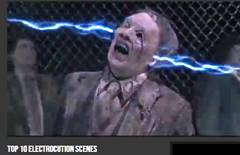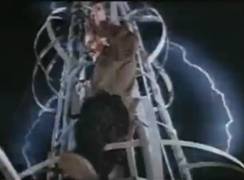More on Insultingly Stupid Movie Physics
By Armando Rodriguez
The Newtonian mechanics historically precedes the movie
industry in two hundred years; it still keeps ignoring its most basic laws.
Tom Rodgers (http://www.intuitor.com/moviephysics/
)wrote a whole book on those insultingly stupid movie scenes that could make
Newton turn in his grave. Electricity and Magnetism laws were unraveled half a
century before Edison and the Lumiere brothers started the movie industry, yet
its products also show as much disrespect to Maxwell and Faraday as they did
with Sir Isaac.

 Movie
electrocutions insult me (http://cinemassacre.com/2013/07/11/top-10-electrocution-scenes/).
For instance, when someone is electrocuted without the necessary flow of an
electric current, it really gets me going. These movie directors don’t get the
simple concept that for someone to get fried by electricity there must be at
least two points of contacts; one for current to go in and another to go out.
Also, for the current to have any reason for flowing , these two points must be
at different electrical potentials; for instance, two hands in the same piece of
metal won’t do. The birdies that land and stay on hot wires don’t fry; everybody
seems to know that, except movie directors.
Movie
electrocutions insult me (http://cinemassacre.com/2013/07/11/top-10-electrocution-scenes/).
For instance, when someone is electrocuted without the necessary flow of an
electric current, it really gets me going. These movie directors don’t get the
simple concept that for someone to get fried by electricity there must be at
least two points of contacts; one for current to go in and another to go out.
Also, for the current to have any reason for flowing , these two points must be
at different electrical potentials; for instance, two hands in the same piece of
metal won’t do. The birdies that land and stay on hot wires don’t fry; everybody
seems to know that, except movie directors.
 The
bad guy goes up a metallic structure; in his pursue, the good guy tears a cable
out of a conveniently nearby breaker box with a one hand single pull and pushes
it onto it… the bad guy is killed while lightning bursts out of him.
Even disregarding that a tearing a half
an inch cable from breaker box is no piece of cake, there are still grounds for
insult:
The
bad guy goes up a metallic structure; in his pursue, the good guy tears a cable
out of a conveniently nearby breaker box with a one hand single pull and pushes
it onto it… the bad guy is killed while lightning bursts out of him.
Even disregarding that a tearing a half
an inch cable from breaker box is no piece of cake, there are still grounds for
insult:
·
The metallic structure, the bad guy and whatever
wire hits it, everything will be at the same potential.
So, none of the imaginable electrical current paths can possible go
through the bad guy.
·
Yard long voltaic arcs require millions of volts,
not the kind of juice breaker boxes or half an inch cables are designed handle.
·
Arcs won’t jump from one point to another in the
same metal structure, because they would be at practically the same potential.
For an arc to happen there must be a very good isolation between the two points.
·
By the way…what prevented such long arcs from
jumping to the good guy’s hand?
Another good one, is the little radio that drops into a
bath tub creating 4th of July kind of pyrotechnics while the victims
is electrocuted or even worst, the killer smashes a light inside a swimming pool
and electrocutes the victim when she plunges into it (this director found no one
to tell him that pool lights use 12 v bulbs).
 My
favorite on this stupid electrocution category came in Season 4 episode 11
(titled "Dead") of TNT series “Covert Affairs”.
The hero character here is a CIA operative named Annie Walker, a steaming
hot blonde that had just gone rogue and had dyed her hair so no one (except all
the TV viewers) can recognize her as a brunette (1).
Well, Annie wants to pull some
information out of this bad guy she had captured and tied to a chair.
This guy is so bad that even a civil right activist would justify some
electrical torture. To that purpose, she
puts the guy’s right foot into a bucket with water and then she goes for a
nearby lamp and yanks the power cord from it (2). She splits the cable a few
inches and slowly moves towards him while creating small sparks by rubbing the
two wires she’s holding (3). Annie
asks a question that the bad guy refuses to answer and she threatens to stick
the two wires onto him (4). When he
is about to talk, he gets shot in perfect movie style, tumbling him down
together with his chair knocking the cables from Annie’s hands.
The water spills from the bucket reaching the cable that is now laying on
the floor and puff… the lights go out (5). Enumerating the insults:
My
favorite on this stupid electrocution category came in Season 4 episode 11
(titled "Dead") of TNT series “Covert Affairs”.
The hero character here is a CIA operative named Annie Walker, a steaming
hot blonde that had just gone rogue and had dyed her hair so no one (except all
the TV viewers) can recognize her as a brunette (1).
Well, Annie wants to pull some
information out of this bad guy she had captured and tied to a chair.
This guy is so bad that even a civil right activist would justify some
electrical torture. To that purpose, she
puts the guy’s right foot into a bucket with water and then she goes for a
nearby lamp and yanks the power cord from it (2). She splits the cable a few
inches and slowly moves towards him while creating small sparks by rubbing the
two wires she’s holding (3). Annie
asks a question that the bad guy refuses to answer and she threatens to stick
the two wires onto him (4). When he
is about to talk, he gets shot in perfect movie style, tumbling him down
together with his chair knocking the cables from Annie’s hands.
The water spills from the bucket reaching the cable that is now laying on
the floor and puff… the lights go out (5). Enumerating the insults:
1.
Not electrical, but still stupid
2.
Maybe Rambo, with the arm size of Annie’s waist
can snap a cable out of a lamp and still
would have need some tool for
stripping the insulation from the wire.
3.
The slightest contact between the two wires would
have produced a big blinding puff and, fortunately
for the cable bearer, the breakers are
likely go off before white hot wires can burn her hands to the bone.
4.
If she’s poking the victim with the two wires,
what’s the foot in the bucket for? I’m sure this director have heard or read (or
maybe even seen in some other movie) about this foot in the bucket thing, but
has miserably missed the point… One
of the wires must be attached to the bucket and the other is for poking the
victim’s body, always avoiding those current paths that may go through his heart
and silence him for good.
5.
Breaker didn’t go off when the wires had a direct
contact, but touching water… that did it! Contrary to common beliefs, pure water
is as good an insulator as the plastic around the cables, yet there’s always
enough minerals dissolved in tab water as to make it a fairly good conductor,
yet, far from being as good as the copper in the wires!
“Breaking Bad” was a great TV series, maybe the best ever.
Chemistry may not have been perfect (http://www.telegraph.co.uk/culture/tvandradio/10218885/Breaking-Bad-The-science-behind-the-fiction.html
) … neither have physics. Here are two
examples:
·
The battery…
 In
episode
nine, series two, due to Jesse’s clumsiness, he and Mr. White find
themselves stranded in middle of the desert. Their RV’s battery is dead, the
generator had caught fire and Jesse wasted all their drinking water in an
attempt to extinguish it. Mr. White
comes up with this brilliant idea of building a battery with some metal foils,
nuts, washers and a few beakers of acid. It’s true that such a device behaves as
a battery, but each of those beakers would deliver about one volt, so he would
have needed so many of those beakers in series to build above 12 volts in order
to charge the battery (it seemed no more than like six of them).
But OK, maybe it was the kind of battery
that exposes the cells, so he could have charged one cell at a time. Now there
comes the issue of the available current for charging… it is proportional to the
metal area and with the small foils and nuts shown on the scene, it would have
taken a lot more than a few hours to charge a single cell. But there’s more, the
thin wires out of the beakers are left connected to the battery in their motor
starting attempt, as it somehow the few milliamps out of their primitive battery
could have been of any help in the hundred or so Amperes required for starting
the RV’s motor… that was insulting.
In
episode
nine, series two, due to Jesse’s clumsiness, he and Mr. White find
themselves stranded in middle of the desert. Their RV’s battery is dead, the
generator had caught fire and Jesse wasted all their drinking water in an
attempt to extinguish it. Mr. White
comes up with this brilliant idea of building a battery with some metal foils,
nuts, washers and a few beakers of acid. It’s true that such a device behaves as
a battery, but each of those beakers would deliver about one volt, so he would
have needed so many of those beakers in series to build above 12 volts in order
to charge the battery (it seemed no more than like six of them).
But OK, maybe it was the kind of battery
that exposes the cells, so he could have charged one cell at a time. Now there
comes the issue of the available current for charging… it is proportional to the
metal area and with the small foils and nuts shown on the scene, it would have
taken a lot more than a few hours to charge a single cell. But there’s more, the
thin wires out of the beakers are left connected to the battery in their motor
starting attempt, as it somehow the few milliamps out of their primitive battery
could have been of any help in the hundred or so Amperes required for starting
the RV’s motor… that was insulting.
·
The other example involves magnetism…
Electric forces between point charges will weaken with the
square of the distance. The electric field is defined as force per unit of
charge and so, it also weakens at the same rate or as said, with the square of
the distance. An electric dipole is
formed by two equal charges, one positive and one negative, separated by a small
distance. In nature, dipoles are as common as point charges, for instance a
water molecule is an electric dipole. The electric fields of a dipole weakens
with the third power of the distance, when this distance is large compared to
the charge separation. So, the field of a dipole weakens even faster than that
of point charges and here is kick... the force of a dipole field on a another
dipole is not even proportional to the electric field, but only to its rate of
change in space. A dipole in a constant field experience no net force; it can
make it turn, but can't make it move. The field rate of change with
distance weakens even faster… with the 4th power of the distance, in
numbers: if the distance is
doubled, forces go 16 times weaker.
All the above is for explaining why forces between dipoles
are very strong when near, but weaken to almost nothing with a little distance
and guess what? In nature there's no such thing as a magnetic charge, there are
only magnetic dipoles. So forces between magnets, which are magnetic
dipoles are very strong when near, but they practically vanish a few magnet
sizes apart. Ferromagnetic materials such as alloys of iron, cobalt or
nickel, turn into magnets under the influence of a magnetic field, so they
become magnetic dipoles and behave as such.
 All
this explains why a powerful magnet, like the ones used in cranes for lifting
cars, won't lift even a nail just a couple feet away. There's this scene, in
Breaking Bad episode 47th, titled “Live Free or Die”, where Mr. White
uses a magnet from one of these cranes for erasing a computer hard drive.
The magnet is set inside a truck they park on the street outside the evidence
room where the target computer is being kept. The scene shows everything
in that room, tens of feet away, flying towards the wall and pilling up there.
The director, showing some respect for Newton’s third law, allowed the
truck to also be lifted until it leaning onto the wall.
All
this explains why a powerful magnet, like the ones used in cranes for lifting
cars, won't lift even a nail just a couple feet away. There's this scene, in
Breaking Bad episode 47th, titled “Live Free or Die”, where Mr. White
uses a magnet from one of these cranes for erasing a computer hard drive.
The magnet is set inside a truck they park on the street outside the evidence
room where the target computer is being kept. The scene shows everything
in that room, tens of feet away, flying towards the wall and pilling up there.
The director, showing some respect for Newton’s third law, allowed the
truck to also be lifted until it leaning onto the wall.
Though the scene above already qualifies as ISMP, it also
ignores the ferromagnetic shielding effect.
If a magnet is allowed to stick to a metal sheet, like one from a
refrigerator or a car, no further magnetic s effects would be seen.
The magnetic field seems as having been swallowed by the ferromagnetic
sheet for it being about thousand times more magnetically permeable than air.
The body of the truck’s back cabin is likely to be made of steel sheets,
same as cars. Leaning to the wall, as
shown by the picture above, the magnet would be strongly pulled towards the
sheet sticking to it, but still no significant magnetic field would exist
outside the truck.
In the this episode, Mr. White succeeds in erasing the
laptop’s hard drive with the above described procedure, yet no one ever have
accomplish that of erasing a hard drive with a magnet.
A little Google search will render the
following: though fields from magnets do
manage to erase magnetic tapes and magnetic strips on credit cards, they
completely fail against shielded magnetic materials in hard drives. Those who
had reported their attempts to erase a hard drives with a magnets, have ended up
recommending some other method for the job, most of them involving hammers or
torches. An experiment reported in K&J Magnetic Inc. website is specially
enlightening (http://www.kjmagnetics.com/blog.asp?p=hard-drive-destruction).
Movies have always incorporated current technologies in
their stories and so computer related scenes are becoming as frequent and
insulting as those involving the violations of the laws of nature.
A recurring insulting scene is that of this nerdy character that operates
a computer while his boss looks at the screen over his shoulder, on the sound
track you can hear the clicking of his fingers over the keyboard.
First, it lets you wondering why these movie computer guys never use a
mouse… OK, that’s only slightly insulting, but then here it comes the juicy one…
the boss says-We’re running out of time!-
next, you can hear the keys going faster in the sound track, that’s
insulting.
A few more insults:
·
The boss asks the geek- Can you hack into the
Pentagon server (or NSA, White House, CIA… etc.)? – The geek answers - Sure,
give me a minute!
·
An agent gets near his target, a remote geek
pairs both their cellular phones and now the agent can listen to whatever the
microphone in the target’s cellular is picking up.
·
The boss asks the geek - Log into the database
and find me all the owners of 1995 Mustangs that have bought a pair of pants in
New York’s Macy department store in the last two weeks – Here goes the sound
track with the fast keyboard clicking and piece of cake… mug pictures of the
guys start showing on the computer screen.
A good movie computer geek can do anything… he/she can show
a live stream from any security camera in the world, hack into any satellite or
write any computer program, a Trojan horse or a virus in minutes.
Anyone that has ever developed a piece of software knows how hard it is
to design, write, test, debug and document their work… yes, it is insultingly
stupid.
Movies have not only deceived their viewers about the laws
of nature, but are also driving them into the paranoia of being heard and
watched through all these modern gadgets like computers,
tablets, smart phones and
TV, etc. On the ABC show “Shark
Tank”, this entrepreneur throws his sales pitch with… “You are being watch!”.
His invention consisted in a plastic
clip for covering the laptop camera. He got squashed by the sharks for business
reasons, but still they shared that camera spying was a real threat.
There’s a difference between something being possible, to that of being
likely. Here are a few the things that need to happen for camera or microphone
spying:
·
First, some sort of malicious software must be
introduced into the target’s computer without being blocked by its firewall or
malware protection software.
·
Only specified events (like keyboard hit, mouse
move, specific network activity, etc,) can bring a computer out of the “Sleep”
state, to change these settings, administrator privileges are needed.
·
If the computer is off, only a finger on the
power button can bring it back on.
Bottom line? Though possible, it is not as easy as shown on
the movies.
Sometimes a lot of research goes into a movie’s wardrobe
and there is even an Oscar for that, yet science and technology does not seem to
deserve the same kind of attention. Unfortunately,
the only ones insulted by the gross violations of the laws of nature or by the
ignorance of the principles behind technology, are us science and tech geeks,
the rest are happy to believe anything they see, as long as it is entertaining.
Movies are praised and awarded for their fidelity to historic events or for
their political or philosophical messages, but never for their fidelity to
scientific knowledge or their teachings of the laws of nature. So… why would
movie directors would be inclined show to any respect?

 Movie
electrocutions insult me (http://cinemassacre.com/2013/07/11/top-10-electrocution-scenes/).
For instance, when someone is electrocuted without the necessary flow of an
electric current, it really gets me going. These movie directors don’t get the
simple concept that for someone to get fried by electricity there must be at
least two points of contacts; one for current to go in and another to go out.
Also, for the current to have any reason for flowing , these two points must be
at different electrical potentials; for instance, two hands in the same piece of
metal won’t do. The birdies that land and stay on hot wires don’t fry; everybody
seems to know that, except movie directors.
Movie
electrocutions insult me (http://cinemassacre.com/2013/07/11/top-10-electrocution-scenes/).
For instance, when someone is electrocuted without the necessary flow of an
electric current, it really gets me going. These movie directors don’t get the
simple concept that for someone to get fried by electricity there must be at
least two points of contacts; one for current to go in and another to go out.
Also, for the current to have any reason for flowing , these two points must be
at different electrical potentials; for instance, two hands in the same piece of
metal won’t do. The birdies that land and stay on hot wires don’t fry; everybody
seems to know that, except movie directors.  The
bad guy goes up a metallic structure; in his pursue, the good guy tears a cable
out of a conveniently nearby breaker box with a one hand single pull and pushes
it onto it… the bad guy is killed while lightning bursts out of him.
The
bad guy goes up a metallic structure; in his pursue, the good guy tears a cable
out of a conveniently nearby breaker box with a one hand single pull and pushes
it onto it… the bad guy is killed while lightning bursts out of him.
 My
favorite on this stupid electrocution category came in Season 4 episode 11
(titled "Dead") of TNT series “Covert Affairs”.
My
favorite on this stupid electrocution category came in Season 4 episode 11
(titled "Dead") of TNT series “Covert Affairs”. In
e
In
e All
this explains why a powerful magnet, like the ones used in cranes for lifting
cars, won't lift even a nail just a couple feet away. There's this scene, in
Breaking Bad episode 47th, titled “Live Free or Die”, where Mr. White
uses a magnet from one of these cranes for erasing a computer hard drive.
The magnet is set inside a truck they park on the street outside the evidence
room where the target computer is being kept. The scene shows everything
in that room, tens of feet away, flying towards the wall and pilling up there.
All
this explains why a powerful magnet, like the ones used in cranes for lifting
cars, won't lift even a nail just a couple feet away. There's this scene, in
Breaking Bad episode 47th, titled “Live Free or Die”, where Mr. White
uses a magnet from one of these cranes for erasing a computer hard drive.
The magnet is set inside a truck they park on the street outside the evidence
room where the target computer is being kept. The scene shows everything
in that room, tens of feet away, flying towards the wall and pilling up there.